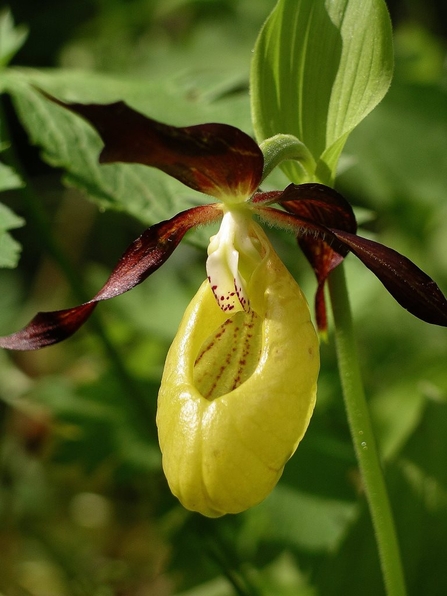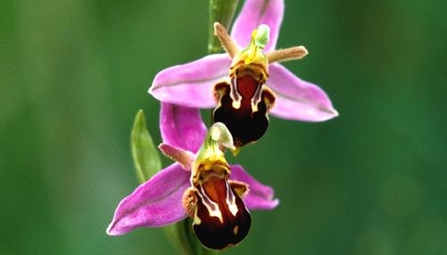There are many different types found throughout the world, but only one Cypripedium calceolus is native to Britain. The specific name calceolus derives from the Latin for 'shoe', and like the English name, refers to the slipper-like appearance of the pouch.
Darwin and the Lady's Slipper

Bradford Museums and Galleries
As a ‘deceptive flower’, the orchid’s pouch gives off a honey smell that implies an abundant supply of nectar. Insects land on the "lip", wander towards the greatest intensity of scent, only to discover itself on the smooth inner surface of the lip and that there is no nectar at all. Downward inclined hairs prevent it going back the way it came. The insect must then find its way to a small opening at the base of the flower and in the process of wriggling its way through, it deposits pollen collected from other encounters with Lady's Slippers, ensuring pollination.

Llanymynech Rocks - Bee Orchid (photo. Celia Todd)
Deceptive flowers are great examples of nature adapting and evolving to ensure their continued existence. Look out for the Bee Orchid, with a flower that mimics the look and smell of a bumble bee. They line the sandy paths at Wood Lane nature reserve in July.
In trying to illustrate his theory of adaptations in nature, Darwin propagated numerous orchids, but was always unsuccessful in growing a Lady's Slipper. It was a species that caused him huge frustration - a mystery that he carried to his grave.
Mystery solved
In 1990 researchers discovered that Lady's Slipper Orchids could also reproduce asexually. It has underground branching stems that produce a clone of the parent plant. This ability has allowed the species to avoid extinction- another prime example of nature's will to survive.
Status today
In the UK the species was formerly widespread (but never common) across northern England, particularly in the limestone area of the Yorkshire Dales. It suffered a serious decline in the 19th Century due to over collection by gardeners. At one point there was just a single flowering plant in existence!
High tech propagation techniques – just like the ones used for the orchids on sale in supermarkets – have led to a successful species recovery programme.
It has been reintroduced to its former range, using propagated plants from wild stock. The site supporting the native population is a European protected site that is kept a secret to safeguard it.
The Darwin plaque in Shrewsbury Unitarian Church.
A plaster impression of a Lady's Slipper can be seen in the Unitarian Church in Shrewsbury and it commemorates Darwin's association with this mysterious flower.
I can faithfully report that Charles Darwin is delighted that lady’s Slipper Orchids are safe.
An excerpt from Darwin's Fertilisation of Cypripediums (1867)
As the sexes of Orchids form a subject of considerable interest, I beg to forward you the accompanying specimens of Cypripedium insigne. Of this I have several plants, all however originally derived from the same piece, but in spite of numerous attempts, I have uniformly failed to fertilise the flowers.

